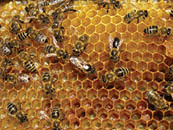
from Does God Exist? September/October 2012
FLOOD EVIDENCE. It is becoming increasingly difficult for skeptics of the Bible to maintain that the Bible is just a collection of ancient myths with no credibility or support. In the past several months several secular magazines have run major articles which lend credence to the biblical account. In the July/August 2012 issue of Discover magazine (page 42) is an article by David Montgomery titled “Traces of the Great Flood.” While Montgomery goes to great lengths to deny that things like the Grand Canyon were formed by a flood (correctly so), he does show that many places on the earth show that massive flooding has taken place. The issues to the extent of the flood of Noah and what effect that flood would have on the morphology of the earth remain unanswered, but relegating the biblical account of the flood to myth is extremely hard to do if one looks at all the evidence with an open mind.
ARCHAEOLOGICAL PROGRESS. In a similar vein, archeological discoveries continue to bolster confidence in the biblical account. Biblical Archaeology Review and its editor Hershel Shanks have not always been supporters of the integrity of the Bible, but in the past year it seems there has been a change in the magazine’s approach. In the July/August 2012 issue are three articles that have a positive relationship with Scripture. Shanks maintains that the inscription on a burial box that identifies the inhabitant as “brother of Jesus” is valid and not a modern day forgery, and in a recent trial the owner of the box was exonerated of forgery by a Jewish court. Another article backs up 1 Kings 14:25 and its claim that King Shishak of Egypt marched against Jerusalem. A third article discusses how inscriptions help date the Psalms.
NATIONAL ATHEIST PARTY (NAP). Troy Boyle, a 45-year-old corporate legal representative, founded a political party based on the belief there is no God and that secularism is a viable belief system for social and political progress. The “Reason Rally” in Washington, D.C., March 24, 2012 that we mentioned in a previous issue of this column (July/August 2012, page 28) was a product of this group’s activity. This group is registered as a 527 political party and planned a political convention October 5 – 6, 2012, but the convention has been moved to 2013 because of a lack of funds. When atheism is both a religion and a political party it is as dangerous as any extremist group. NAP is not napping. (See the article in this issue on page 29.) Source: TheBlaze.com, August 31,1202.
DARK MATTER’S DESIGN. One of the great cosmological mysteries of today is the fact that we have galaxies spinning at such high velocities that they should be flying apart. The fact that they are not flying apart means something is holding the system together. Scientists believe that something is a massive cloud of a form of matter that does not interact with ordinary matter. This huge cloud is called “Weakly Interacting Massive Particles,” known by the acronym WIMPs. As our solar system passes through this cloud, the earth and everything on it are bombarded with WIMPs. In fact, billions of these particles pass through your body every second. They would blast us into bits if it were not for the fact that they do not interact with ordinary matter. Astrophysicists at the University of Michigan and Stockholm University report that cosmic rays and natural radioactive substances expose us to more radiation each second than we would receive from WIMPs in a lifetime. There is no need for us to fear dark matter or WIMPs. To design a particle that can be cosmic glue and hold everything together, and yet not interact with matter destroying it is such a complex issue that so far no one has designed a test to measure WIMPs. The complexity of the design of the cosmos is a great evidence for God and for his wisdom. Source: Science News, May 19, 2012, page 2.
 TATTOO/PIERCING AND ALCOHOL USE. A difficult issue for many Christians is the issue of whether to do body piercing and tattoos or not. Data shows that at least a third of U.S. adults have non-earlobe piercings. Arguments against these practices center around whether they convey a negative image that the person presents a risk-taking life style — morally and socially. A new study shows that alcohol consumption is significantly higher in people with tattoos and piercings. A study of people exiting bars showed that women with piercings and tattoos had breath alcohol levels twice as high as women with no piercings or tattoos. The difference for men was significant, but not as great as for women. There are various ways to interpret this, but it could be an indication that people who get tattoos and piercings have a propensity for taking health risks. There is an image that these practices convey and which we all need to consider. Source: Science News, May 19, 2012, page 4.
TATTOO/PIERCING AND ALCOHOL USE. A difficult issue for many Christians is the issue of whether to do body piercing and tattoos or not. Data shows that at least a third of U.S. adults have non-earlobe piercings. Arguments against these practices center around whether they convey a negative image that the person presents a risk-taking life style — morally and socially. A new study shows that alcohol consumption is significantly higher in people with tattoos and piercings. A study of people exiting bars showed that women with piercings and tattoos had breath alcohol levels twice as high as women with no piercings or tattoos. The difference for men was significant, but not as great as for women. There are various ways to interpret this, but it could be an indication that people who get tattoos and piercings have a propensity for taking health risks. There is an image that these practices convey and which we all need to consider. Source: Science News, May 19, 2012, page 4.
WHAT IS LIFE? There are a lot of articles in the press these days about how life got started on the earth. The public is being led to believe that life forms easily by chance processes, and that there are many different forms of life that are radically different from what we see on earth. Most of what is being presented is not very good science. Life is typically defined as that which can move, breathe, respond to outside stimuli, and reproduce. This definition has many problems, because some forms of things we feel are living do not fit the definition well. A jellyfish has no brain, no blood, no bones, and no heart. Its nervous systems is very elementary. It really is not a fish at all and is in fact 95% water. A virus does not breathe. Suggestions that life could be based on something other than carbon and oxygen do not work very well either. Other group IV elements in the periodic chart can do some of the chemical things that carbon can do, but their density and electronegativity do not allow them to do others. Life is special, unique, and carefully designed. We may find life elsewhere in space, but, like life on earth, planetary conditions and the life forms would have to be carefully matched. So far that does not seem very likely. Source: Ocean Conservancy, Spring 2012, page 7. (See also “How Many ‘Earths’ Are There?” on page 30.)
SWARM INTELLIGENCE AND THE MIND. In the Smithsonian magazine (March 2012, page 14) there is a fascinating article by Carl Zimmer about bee swarms and how decisions are made by the hive. Dr. Tom Seeley of Harvard University has been studying how swarms of bees make decisions. The method is quite simple in appearance. When a scout bee comes back to the hive it does a “dance” in the hive to tell  the other bees where she has been and how good the place is. Seeley had set up five locations for a bee hive, with different conditions in each one. When a worker came back from the best place the worker would make some 200 circuits or more waggling violently all the way. If the place was not as good there would be fewer circuits and less energetic waggling. All this would send another wave of bees to the place in question, and they would do what the first bee did. A third wave would then investigate the place. Eventually the hive moved to the best place. The idea that the queen makes the decision is incorrect. The hive makes the decision and the queen obeys what the hive decides. Neuroscientists believe that the brain works in the same way. Single neurons make the first contact and other neurons join in, allowing a full decision to be made. God’s design for the swarm and his guidance on how it can make good decisions helps us understand the natural world, and perhaps how our brains work as well.
the other bees where she has been and how good the place is. Seeley had set up five locations for a bee hive, with different conditions in each one. When a worker came back from the best place the worker would make some 200 circuits or more waggling violently all the way. If the place was not as good there would be fewer circuits and less energetic waggling. All this would send another wave of bees to the place in question, and they would do what the first bee did. A third wave would then investigate the place. Eventually the hive moved to the best place. The idea that the queen makes the decision is incorrect. The hive makes the decision and the queen obeys what the hive decides. Neuroscientists believe that the brain works in the same way. Single neurons make the first contact and other neurons join in, allowing a full decision to be made. God’s design for the swarm and his guidance on how it can make good decisions helps us understand the natural world, and perhaps how our brains work as well.
ATHEISTS THREATEN EVICTION OF CHRISTIANS AT “REASON RALLY.” Citizen magazine (June/July 2012, page 8) reports that an atheist rally, called “Reason Rally,” held at the Washington Monument in March was anything but reasoning. Richard Dawkins was the main speaker and urged his fellow atheists to “ridicule and show contempt” for religious beliefs. Singer Tim Minchin was also featured and used 75 F-words in his presentation. A favorite sign carried at the rally was “So many Christians, so few lions.” When a Christian group called “True Reason” requested permission to take part they were threatened with eviction by security guards. David Silverman, head of American Atheists, said to them, “We are not going to D.C. for ‘dialogue’ with people who believe ridiculous things — we are going to have fun with other like-minded people.”
Later the same month an atheist soldier, Justin Griffith who is stationed at Fort Bragg, NC, organized what is described as “the first major atheist event on a U.S. military base.” Griffith’s argument to get the Army’s endorsement was that they had allowed and endorsed the Bill Graham Evangelistic Association program called “Rock the Fort” on September 25, 2010. Griffith is backed by the Freedom From Religion Foundation and other atheist groups.
Richard Dawkins was also a headliner at the Fort Bragg festival along with the rock band Aiden and singer/songwriter Roy Zimmerman. The elite skydiving team the U.S. Army Golden Knights performed, “despite the reluctance of some of the team’s Christian members.” Reports in TheBlaze.com said that the event was made possible by $50,000 supplied by the U.S. Army and $70,000 supplied by an atheist organization in Raleigh, NC. According to TheBlaze.com organizers had hoped for a crowd of 5,000 but there were “at least several hundred” who showed up. That makes it interesting to consider the cost per attendee.
Army Chaplain Chuck Williams pointed out that atheist rallies, like the ones at the Washington Monument and Fort Bragg, are using “government-owned venues to ridicule, mock, and disparage those of our fellow soldiers and family members who do profess a faith in God.” Sources: Citizen magazine, June/July 2012; TheBlaze.com, April 1, 2012; MSNBC.com, March 24, 2012.
THE GENOME AND DISEASE. A claimed benefit of constructing the human genome was that the information could be used to predict what diseases might cause a person’s death. This was supposed to enable genetic engineering, and allow insurance companies to save money by refusing to insure people who had a genetic tendency for a particular disease. Johns Hopkins researchers have examined data from 53,666 identical twin pairs to see if the risk of 24 different diseases could be predicted. Since twins have the same genetic makeup, it was thought that they should have the same risk of these diseases, which included cancer, heart disease, diabetes, and Alzheimer’s. The bottom line is that the genetic tendency just was not reliable. Epidemiologist Walter Willett of the Harvard School of Public Health said, “Basically, you can still do better just by putting somebody on the scales and asking about their smoking history.” The indication is that our genes are not the only factor influencing our illnesses. Source: Science News, May 5,2012, page 11.
HOW MANY “EARTHS” ARE THERE? Researchers studying the existence of planets going around other stars have catalogued over 700 planets so far, but a more general study shows that on the average every star in the galaxy has 1.6 planets. That number happens because some have no planets and some have at least ten planets. If that number is correct, that would mean that there are 100 billion planets in the Milky Way galaxy. So far the planets we see are way too big and have massive problems in their orbits and makeup to support life. The question is, “If there are 100 billion of them wouldn’t one have the right conditions?” We can watch stars form, and we know that process produces a large amount of debris surrounding the new star. If what we see happening is what produced all of the stars in our galaxy it would seem possible that another planet like earth could form. It would be the right size, have the right spin, and be the right distance from the star. However, there would still be a vast number of other conditions necessary for life to be able to survive, such as the shape of the orbit, the distribution of water surface area, the chemical makeup, the sequence of chemical reactions, and the magnetic structure. We have a list of 47 such conditions that would be critical for life at www.doesgodexist.org/Charts/EvidenceForDesignInTheUniverse.html. All of those conditions could also have been met if an intelligence was involved in the formation of the system. The bottom line is that no matter how many planets are found going around other stars, there is no negative implication for arguments related to the existence of God. We are just learning more and more about the processes involved when “God created the heaven and the earth.” Sources: Science News, February 25, 2012, page 12, and Discover magazine, March 2012, page 15.
COLOR IN LIVING THINGS. In the “Dandy Designs” column of our May/June 2012 issue we told about how bird feathers create beautiful colors without pigments. Along that line the May 2012 issue of Scientific American (page 76) has a fascinating article by Philip Ball on how various animals create color. We normally think that animal colors are made up of pigments, like paint. However, Ball describes seven different methods that animals use to create colors or to change color quickly. In butterfly wings there are reflecting layers made from a natural polymer called chitin separated by air sacks. In birds there are layers of rods made of melanin embedded in keratin (a protein you have in your fingernails). These layers separate colors of light and refract them at different angles. By changing the angles of the layers the colors can be changed. This method is used by the Lawe’s parotia bird to change its blue-green feathers to yellow with a slight movement. Another method is called the Christmas tree effect because it uses diffraction to scatter the colors. Swallowtail butterflies use light bouncing bowls to separate colors. Another butterfly called the emerald-patched cattleheart uses photonic crystals to select certain wavelengths of light to reflect. Certain sea worms use hollow fibers to reflect the red part of the spectrum giving them an iridescent red color. Hummingbirds and peacocks use deformed matrices to produce color and squids use reversible proteins. Research continues to see how man can use these designs, but the original design principles cannot be a product of chance, and speak eloquently of the methods of the Creator in everything we see on the earth.
 HAS THE “GOD PARTICLE” BEEN FOUND? In July 2012 the news media went wild with the news that the Higgs boson, the so-called “God particle,” had been found. News reports carried statements like “Scientists 99.999% sure ‘God Particle’ has been found” and “Prepare the fireworks: the discovery of Higgs boson is finally here” and “the most important physics discovery of the century.” The London Daily Mail said, “Professor Higgs wipes a tear from his eye as fellow scientists find his ‘God particle’ on ‘momentous day for science’ — 40 years after he predicted its existence.” But what is this elusive particle and has it really been found? Higgs boson is a theoretical sub-atomic particle proposed by Peter Higgs in 1964 that supposedly gives mass to every other particle. Whether there really is such a particle and whether it has been found is being widely disputed at the time of this writing. Stay tuned for more.
HAS THE “GOD PARTICLE” BEEN FOUND? In July 2012 the news media went wild with the news that the Higgs boson, the so-called “God particle,” had been found. News reports carried statements like “Scientists 99.999% sure ‘God Particle’ has been found” and “Prepare the fireworks: the discovery of Higgs boson is finally here” and “the most important physics discovery of the century.” The London Daily Mail said, “Professor Higgs wipes a tear from his eye as fellow scientists find his ‘God particle’ on ‘momentous day for science’ — 40 years after he predicted its existence.” But what is this elusive particle and has it really been found? Higgs boson is a theoretical sub-atomic particle proposed by Peter Higgs in 1964 that supposedly gives mass to every other particle. Whether there really is such a particle and whether it has been found is being widely disputed at the time of this writing. Stay tuned for more.
Picture credits:
© OSTILL. Image from BigStockPhoto.com
© hoptrop. Image from BigStockPhoto.com
© lineartestpilot. Image from BigStockPhoto.com
